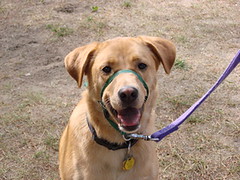I’d like to look at a few products available in stores that can help you while you are retraining your dog to walk without pulling. None of these products work miracles; you still need to train your pet to walk on a loose leash, but these products can be useful in training particularly stubborn dogs.
Standard Harnesses
Contrary to popular belief, standard harnesses do not curb leash pulling. They are really just an alternative to a collar. Some dogs will benefit from a harness, especially those that tend to slip their collars, breeds that have short noses, and breeds that are more prone to suffer collapsed tracheas from pulling (such as small breeds). I’ve actually found harnesses make it easier for some dogs to pull, because they are not pulling against their windpipe and gasping for air. You can still teach your dog to walk on a loose leash using a standard harness, but it will not serve as a ‘helper’ for the training.
Head Collars or Halters
 There are a variety of halters available for dogs that attach around your dog’s muzzle, much like a halter for a horse. These head collars are designed to give you more control over your dog’s movements. When pressure is applied to your dog’s leash, it turns their head back towards you. I use Gentle Leader head collars on two of my dogs all the time. They really help tip the scales in the battle of wills that can ensue during some walks. When your dog pulls with the head collar on, their full body weight isn’t behind the pull. If you have trouble with the training techniques because your dogs are very strong, this product may help you. The first couple of times you use the collar, they will probably not like the new feeling and there will be an adjustment period. Use lots of praise and treats to get your dog used to his new collar so he associates good things with it.
There are a variety of halters available for dogs that attach around your dog’s muzzle, much like a halter for a horse. These head collars are designed to give you more control over your dog’s movements. When pressure is applied to your dog’s leash, it turns their head back towards you. I use Gentle Leader head collars on two of my dogs all the time. They really help tip the scales in the battle of wills that can ensue during some walks. When your dog pulls with the head collar on, their full body weight isn’t behind the pull. If you have trouble with the training techniques because your dogs are very strong, this product may help you. The first couple of times you use the collar, they will probably not like the new feeling and there will be an adjustment period. Use lots of praise and treats to get your dog used to his new collar so he associates good things with it.
I do not suggest using the About-Face training technique using a head collar or halter. The rapid change in directions could potentially cause neck injuries. Use the Lure and Reward method or the Stop ‘n Go method instead. Also avoid using ‘leash corrections’ if you are using a halter. A leash correction is a short, sharp tug on the leash that some trainers use to regain a dog’s attention.
Harnesses for Pulling
There are some specialized harnesses on the market that claim to prevent leash pulling. I can’t speak for all of them, but I have used the the variety of harness that hooks in the front of a dog’s chest. Wearing this harness, your pet’s body is turned back towards you when he pulls. The harness that I am most familiar with and can recommend is the Gentle Leader Easy Walk harness. I used this as a helper to teach Barrett to walk on a leash properly.
Non-reward based products
Some people prefer prong collars to traditional collars, or collars that emit high pitched sounds or spray correction when an undesired behavior occurs. I’m in the positive reinforcement training camp, so I don’t like to use these types of products. Instead of rewarding a dog for good leash behavior, it ‘punishes’ them for bad behavior. While this type of training was the preferred method for many years and can deliver results faster, new innovations in understanding dog behavior have shown that using positive reinforcement is more effective in the long run and helps seal the bond between you and your best friend. It can help to prevent any physical or psychological damage that can be caused by using these products on sensitive dogs.
If you feel that your dog is too stubborn or strong-willed for positive reinforcement training techniques, I urge you to seek out a certified dog trainer to help you succeed. If you decide to use prong or behavioral modification collars be sure to research them and read all included instructions to avoid injuries.
Proper leash walking is one of the hardest things to train your dog. It isn’t a behavior that they’re born with. Leashes constrain dogs and their natural tendency to explore their environment. Be consistent and persistent and you will both succeed. As with any training, keep sessions short and FUN and you will be more successful. Set yourself up for success by starting the training in an area or location with few distractions. Once you’ve mastered loose leash walking there, move on to more challenging locations, like the local park. These products alone will not prevent leash pulling, but used in conjunction with common positive reinforcement leash training techniques, success may come sooner rather than later and can make walking your pet a more enjoyable experience for both of you.
 That Pet Blog That Pet Place Pet Blog
That Pet Blog That Pet Place Pet Blog

Great post. Some great points you highlight in there.